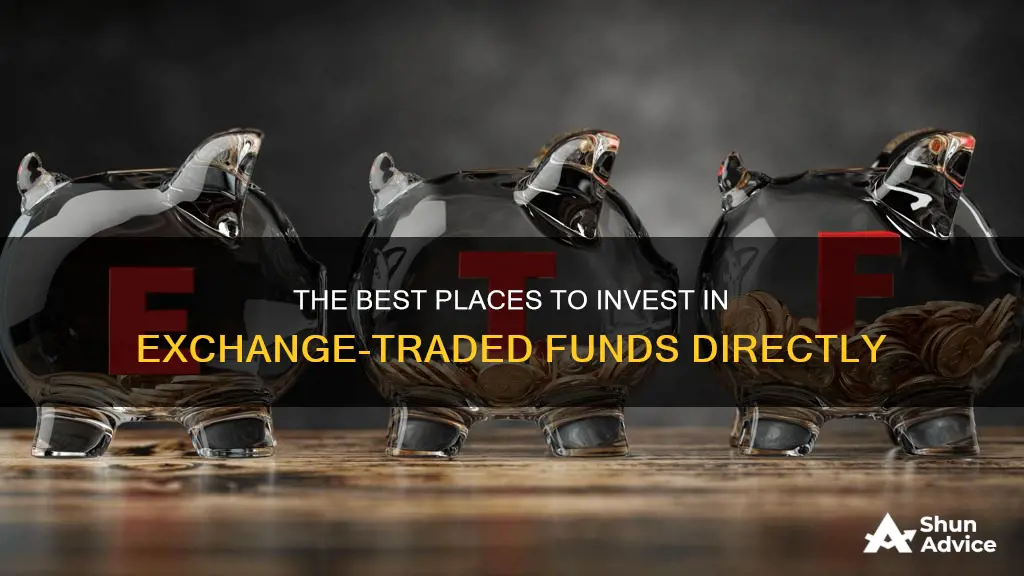
Exchange-traded funds (ETFs) are a type of investment fund that offers the best of both worlds: the ease of stock trading and the diversification benefits of mutual funds. ETFs are a basket of investments like stocks or bonds that can be traded on major exchanges such as the NYSE and Nasdaq. They are a great option for beginners as they are fairly simple to understand and can generate impressive returns without much expense or effort.
ETFs are also more tax-efficient than mutual funds. Mutual funds, especially actively managed ones, trade assets more frequently, resulting in capital gains taxes. ETFs, on the other hand, only incur capital gains taxes when you sell the investment.
When investing in ETFs, it is important to consider the fund's expense ratio, management costs, commission fees, how it fits into your existing portfolio, and its investment quality. Additionally, evaluate ETFs on their own merits rather than assuming they are a one-size-fits-all solution.
| Characteristics | Values |
|---|---|
| Definition | Exchange-traded funds (ETFs) |
| Type of investment fund | Combines the diversification benefits of mutual funds with the ease of stock trading |
| Investment type | Basket of investments such as stocks, bonds, commodities, currencies |
| Trading | Traded on major exchanges like stocks |
| Buying and selling | Bought and sold at any time during the trading day |
| Fees | Often lower fees than other types of funds |
| Diversification | Instant diversification by investing in many assets at once |
| Risk | Generally considered safer than individual stocks due to diversification |
| Liquidity | More liquid (easy to buy and sell) than mutual funds |
| Management | Actively or passively managed |
| Taxes | More tax-efficient than mutual funds |
| Suitability | Suitable for beginners and experts |
What You'll Learn

ETFs vs. mutual funds
Exchange-traded funds (ETFs) and mutual funds are similar in that they both represent managed "baskets" or "pools" of individual securities, such as stocks or bonds. They are less risky than investing in individual stocks and bonds and they both offer a wide variety of investment options. However, there are some key differences between the two.
The most significant difference between ETFs and mutual funds is how they are traded. ETFs trade like stocks and are bought and sold on a stock exchange, with price changes throughout the day. This means that the price at which you buy an ETF will likely differ from the prices paid by other investors. Mutual funds, on the other hand, are executed once per day, with all investors receiving the same price. Mutual fund purchases and sales occur directly between investors and the fund provider, and the fund's price is determined at the end of the business day. ETFs can be bought and sold with other investors on the open market, and shares can be traded throughout the day.
Investment Minimums
Mutual funds typically have minimum investment requirements of hundreds or thousands of dollars. ETFs, on the other hand, can be purchased for the price of a single share, which can be as little as $50 or a few hundred dollars.
Management Style
While both can be actively or passively managed, most ETFs are passive investments that track a market index or sector sub-index. Mutual funds usually come in active and indexed varieties, with most being actively managed by a fund manager or team. Actively managed funds tend to have higher fees and expense ratios due to their higher operations and trading costs.
Tax Efficiency
ETFs are often considered more tax-efficient than mutual funds. As passively managed portfolios, ETFs tend to realise fewer capital gains than actively managed mutual funds. The process of creating and redeeming shares of a mutual fund can trigger capital gains tax liabilities for all shareholders, whereas ETF shareholders only incur capital gains tax when they sell their shares.
Suitability
If you are looking for lower investment minimums, more hands-on control over the price of your trade, or an index fund, then an ETF could be more suitable for you. A mutual fund may be preferable if you want to repeat specific transactions automatically or if you are seeking a fund that could potentially beat the market.
Rental Property vs Mutual Funds: Which is the Better Investment?
You may want to see also

ETF creation and redemption
The creation and redemption mechanism is a key component of how an ETF (exchange-traded fund) functions. This process is executed daily in the ETF industry and allows the ETF share price to be momentarily tethered to supply and demand while staying grounded in the value of the assets held by the fund over the long term. ETFs have a unique creation and redemption mechanism that sets them apart from other investment products.
The creation and redemption process occurs between ETF issuers and large institutional investors known as "authorised participants" (APs). APs create or redeem ETF shares directly with the ETF provider in creation units, which are typically large blocks of at least 25,000 ETF shares. These are generally exchanged in-kind for baskets of the underlying securities and/or cash. APs act as market makers on the open market, providing liquidity to the ETF shares and ensuring that their intraday price approximates the net asset value (NAV) of the fund.
To create additional ETF shares, an AP will purchase all the securities that constitute the ETF in the appropriate proportion to the overall portfolio. They will then exchange this "basket" of securities with the ETF issuer for one or more creation units of the ETF. The AP will then sell these new ETF shares on the stock exchange, where individual investors can buy or sell them throughout the trading day.
The redemption process is the opposite of the creation process. When there are more sellers than buyers of the ETF, the AP may work with the issuer to take excess supply off the market. The AP will buy shares of the ETF on the open market and accumulate a sufficient number of shares to constitute a creation unit. They will then exchange these ETF shares with the ETF issuer for a basket of securities of equivalent value. The AP may then sell these securities in the open market.
The creation and redemption process is an efficient way to execute large trade orders. It also helps deliver efficiencies and tighter tracking to the fund's underlying index, typically not seen in traditional mutual funds. APs play a critical role in ensuring the ETF is priced fairly and in line with its NAV, contributing to the appeal of ETFs as cost-efficient, tax-effective, and liquid investment vehicles.
Money Market Funds: Investment Options and Strategies
You may want to see also

Do ETFs pay dividends?
Exchange-traded funds (ETFs) are a type of investment vehicle that pools a group of securities into a fund, allowing investors to buy multiple stocks or bonds at once. They are traded on major exchanges, such as the NYSE and Nasdaq, and their prices fluctuate throughout the trading day. ETFs are known for providing diversification, low expense ratios, and easy buying and selling.
When it comes to dividends, most ETFs do pay dividends to their shareholders. Dividends are a portion of a company's profits that are allocated or paid to investors for holding their stock. In the case of ETFs, the dividends come from the companies whose stocks are held in the fund. These dividends can be paid out directly to the shareholders or reinvested back into the fund.
There are two main types of dividends issued by ETFs: qualified and non-qualified dividends. Qualified dividends are taxed at the capital gains rate, which depends on the investor's income level, while non-qualified dividends are taxed at ordinary income rates. It's important to note that dividends from ETFs are taxable, and investors may need to pay quarterly estimated taxes if they receive a substantial amount.
Some popular dividend-oriented ETFs include the SPDR S&P Dividend ETF (SDY), the Vanguard Dividend Appreciation ETF (VIG), and the iShares Select Dividend ETF (DVY). These ETFs focus on companies with a history of paying high dividends, making them attractive for investors seeking regular income.
Overall, ETFs that pay dividends offer investors a way to generate income while also benefiting from the diversification and ease of trading that ETFs provide.
IRA and Mutual Funds: A Smart Investment Strategy
You may want to see also

Can you sell an ETF at any time?
Exchange-traded funds (ETFs) are traded on stock exchanges and can be bought and sold at any time during the trading day. They are similar to stocks in that they are traded on the secondary market, and their prices fluctuate continuously throughout the day.
ETFs are also similar to mutual funds in that they invest in a wide range of securities and provide automatic diversification to shareholders. However, they differ from mutual funds in that they are traded on the open market, and shares can be bought and sold at the discretion of the shareholder. Mutual funds, on the other hand, are bought and sold through the fund company at the end of the trading day and are priced once per day.
ETFs are popular investments because they are relatively inexpensive, easily traded, carry lower fees than other investments, and are more tax-efficient than comparable mutual funds.
It is important to note that there are no restrictions on how often you can buy and sell ETFs, but there may be tax implications when investing in them. Capital gains taxes may result from selling ETF shares, and investors may also face potential distributions of capital gains or income from the fund if they have received dividends.
Key Considerations for Investing in Algorithmic Trading Funds
You may want to see also

ETF advantages and disadvantages
Exchange-traded funds (ETFs) are an increasingly popular investment vehicle, especially for beginners, due to their many advantages. However, there are also some drawbacks and risks to consider before investing.
Advantages of ETFs:
- Diversification: ETFs provide exposure to a wide range of stocks, bonds, and other assets, allowing investors to diversify their portfolio without the time and expense of buying individual securities.
- Low Costs: ETFs have lower operating costs than traditional open-end funds and mutual funds due to their streamlined structure and the absence of certain fees, such as mutual fund redemption fees and annual marketing fees.
- Trading Flexibility: ETFs can be bought and sold throughout the trading day, providing investors with greater flexibility and the ability to make timely investment decisions.
- Tax Efficiency: ETFs tend to be more tax-efficient than mutual funds as they generally incur lower capital gains taxes, which are only passed on to investors upon the sale of the ETF.
- Transparency: Most ETFs disclose their holdings daily, providing greater transparency for investors.
- Risk Management: The inherent diversification of ETFs helps to reduce investment risk.
- Accessibility: ETFs are accessible to investors with limited capital as they don't have minimum investment requirements and can be purchased on a per-share basis.
Disadvantages of ETFs:
- Limited Diversification: Some ETFs, particularly those focused on specific sectors or foreign stocks, may only offer exposure to large-cap stocks, limiting diversification and potential growth opportunities.
- Intraday Pricing: Intraday pricing fluctuations could lead to emotional trading decisions that contradict longer-term investment objectives.
- Costs: While generally low-cost, ETFs are not free, and the costs of investing in an ETF may be higher than investing in a specific stock due to management fees.
- Lower Dividend Yields: While there are dividend-paying ETFs, the yields may be lower than those obtained by owning high-yielding stocks.
- Complexities: Certain ETFs, such as leveraged ETFs, can be complex and speculative, requiring careful evaluation before investing.
- Shutdown Risk: There is a minor risk of an ETF closing, which could result in unexpected fees and capital gains taxes for shareholders.
Overall, ETFs offer a range of benefits for investors, particularly those seeking a low-cost, flexible, and diversified investment option. However, it's important to carefully consider the potential drawbacks and risks associated with ETFs before investing.
Mutual Funds: Risk Scale Placement and Investor Expectations
You may want to see also
Frequently asked questions
Exchange Traded Funds are a collection of securities (such as stocks, bonds or commodities) that can be traded on an exchange like a stock. ETFs are usually designed to track the performance of a particular asset or index.
ETFs are a great way to gain exposure to a wide range of securities, providing diversification and reducing risk. They are also relatively cheap and easy to buy and sell.
ETFs are subject to market risk and, while they are usually low-cost, they are not free to purchase. Additionally, there may be liquidity issues and the potential risk of the ETF closing down.
You will need to open a brokerage account and decide on an investment strategy and exit strategy. You can then research and choose specific ETFs to invest in, using a screener to narrow down your options. Finally, you can set up a regular purchase plan to build your investment over time.







